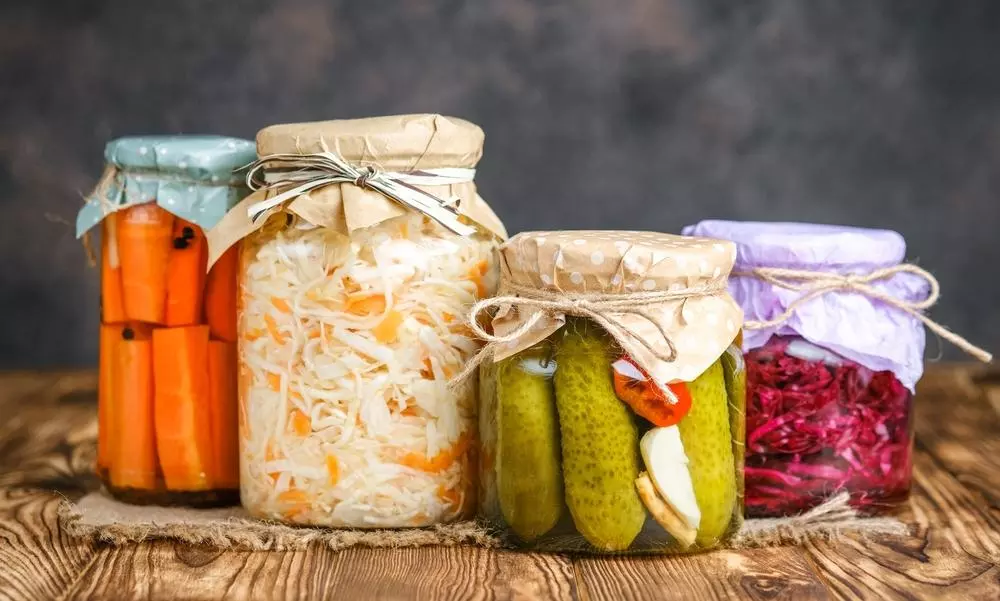Assemble your glass jars and cultures, as you enter the world of fermentation under the guidance of Moina Oberoi
Chef Moina walks us through the basics of setting up your own home kitchen fermentation station
- By Natasha KitturLoading...
- | 8 Aug 2023 12:08 PM IST
 X
X
Fermentation is one of the most sought after methods to preserve food. This age-old technique not only extends the shelf life of your ingredients but also bestows them with a symphony of complex tastes and textures. And while we are already daily acquainted with the process, given the variety of pickles we prepare, setting up a full-fledged fermentation at home can be a little tricky when you don’t seem to have the knowledge that sets the foundation.
Read along as we converse with chef Moina Oberoi, a health & sustainable food entrepreneur and consultant. She is the founder and MD of India’s first kefir yogurt manufacturing company MO’s Superfood and needless to say an expert on all things ferment. Whether you're a seasoned culinary enthusiast or just starting on your gastronomic journey, in this guide chef Moina delves into the essentials of home kitchen fermentation, equipping you with the answers and tools needed to embark on this captivating culinary adventure right in your own abode.
So, gather your ingredients, ready your jars, and prepare to unlock a world of flavours.
What place would be ideal to set up your fermentation station, keeping in mind factors like temperature, sunlight and accessibility?
The ideal spot to set up a fermentation station would be a cupboard or corner in or close to your kitchen that is cool and dark. The darkness helps with maintaining a steady pace for fermentation as well as maintaining temperature. It is important to have as consistent a temperature as possible for good fermentation.
Are there any ingredients that are universal for any kind of fermented food, or a few key ingredients that one must have before they begin this process?
Ingredients depend and vary on the technique of fermentation you use. The most employed fermentation technique is brining, as used in different cultures like torshi pickle, Japanese gari ginger pickle or even the Brazilian pickled chilli. If you are looking to start fermenting at home a lacto-fermented brine technique is a great way to start. For this you need good quality pink salt or sea salt, vinegar and glass jars with airtight lids.
Given that certain ferments require consistent temperatures, how would you suggest this optimum temperature be maintained easily at home?
Finding an optimum location for your station, as mentioned before, that does not have fluctuating temperature is key. Using good quality vessels like glass jars or ceramic containers also help maintain temperature. As you familiarise yourself with the fermenting process, eventually you’ll learn the optimum time for your fermentation environment and get more intuitive with your space. Fermentation is a combination of intuition and experience.
Are there any rules to the skill that one must follow strictly to get optimum results?
The most important rule in this process is to implement actions that avoid spoilage. Spoilage can happen midway during your fermentation process so it is critical to first understand spoilage versus fermentation, and know what to do to circumvent it. Spoilage can happen because of oxidation, when the ferment is overly exposed to oxygen or can also happen due to contamination by yeast or moulds.
What are the safety precautions one should follow during fermentation?
To avoid spoilage, keep control of oxygen exposure by using good airtight containers, maintaining the right ratio of salt water brines and keeping the food nicely coated or submerged under oxygen inhibitors. Also exercise temperature control, your containers need to be in a dark and cool environment. Finally, to avoid contamination, make sure all quipment and surfaces are sanitised or sterilised well. One can use hot water or vinegar water for cleaning and sterilising.
How does one use a starter culture to activate a ferment?
A starter culture is a form of active bacteria. There are many types of starters, be it a scoby for kombucha, koji mould for soy sauce or miso, kefir grains for kefir yogurt and so on. Each starter is prepared and maintained differently. When you are using a mother culture one must make sure the mother culture is healthy before starting the fermentation processes. This can be done by feeding them natural sugars for a period of time according to the specific cultures requirement. Alternately there are starter cultures like a teaspoon of curd to activate a batch of milk to set into curd. When using an active fermented food as a starter one needs to make sure it is of good quality.
What are some visual cues to know when the ferments are ready?
Visual cues are subject to what you are fermenting. For instance, if you are brining you can observe the carbonation that takes place in the salt water during the first few days of fermentation. Generally, by the third to fifth day the bubbles from the carbonation will start to die out or slow down. This is an indication that the bacteria has eaten all the available natural sugars. At this stage you can start tasting and decide whether you would like to continue the fermentation to make the food more sour or stop it altogether.
Is it possible to reuse the fermentation brine for future batches?
Yes, absolutely! In fact the old brine is extremely rich in good bacteria, yeast and enzymes, so always try and save the brine to use for future batches or as a starter.
How do I avoid mould growth during fermentation?
Mould is a form of contamination. So avoiding its formation will depend on its exposure to oxygen and the sterility of the jars used and the surrounding of your fermentation station. Another point to note is that visually when mould on fermented foods is white it is quite often kahm yeast, which is not toxic and can be easily removed. If there is mould of any other colour is it most likely contaminated and not safe.
How can one experiment with flavours and ingredients when it comes to fermented drinks like kombucha?
For flavouring of fermented drinks the key to remember is, a little goes a long way. After the first ferment once you remove your mother culture you can add a combination of various herbs and spices, but do keep in mind that the flavour will only get stronger as you continue to ferment your drink. My suggestion would be to not go over the top and try to keep the combinations simple and complimentary to the flavour of the drink.
How does one maintain the equipment used for fermentation? (e.g., cleaning, sanitising, storing)
If you are looking to maintain your home fermentation station, you can dip all your containers and equipment in a mix of hot water and vinegar or plain vinegar to sanitise them. Always keep the counters clean in the same way before assembling your ferment. Sanitation and cleanliness in the initial stages can go a long way in keeping your ferments safe from contaminants.
How should I store fermented foods once they are ready?
Some fermented foods, like fermented lime pickle for example, can be stored at room temperature for years together, only making the pickle better with time. While most other ferments need to be refrigerated, drop the average temperature down to 4 to 8 degrees in order to stop or slow down the fermentation process. The cool temperature will avoid over fermentation. Make sure to avoid using plastic containers and instead opt for glass or ceramic airtight containers as they are the optimum vessels for storing your ferments.
What are some common issues and troubleshooting tips one might have to navigate through during fermentation?
The common issue is often over-fermenting due to negligence or temperature fluctuation. An important practice is to always have masking tape and a marker handy at your fermentation station so you can diligently label your ferment with the date and time and routinely check your ferments.
Are there any tips and tricks to salvage any fermentation failures or spoilage?
As mentioned before, if there is white mould formation one can simply remove the layer of mould and continue to ferment. If you sense it might have spread further in the jar you can relocate your ferment in a newly sanitised jar for safe measure while using the same brine.
What steps can one take to extend the shelf life of fermented products?
Fermentation as a process is used to increase the shelf life of edibles. These products are natural preservatives for fresh foods. To further extend the shelf life of your ferments remember that they require minimum oxygen exposure and need to be kept in the refrigerator at an average of 4°C to slow down the fermenting process.
If this guide has got you excited to set up your own station at home, chef Moina also has an online class where you can learn to make your own sauerkraut, lacto-fermented veggie pickles, baba ganoush and more. Click here for more information (and maybe even to enrol).

Natasha Kittur
Natasha Kittur is an aspiring writer. Her love for anything with cheese and spice is profound, but a white sauce pasta always tops her list. In her free time you will catch her reading or watching crime books and shows or go on and on about psychological experiments and theories. She aims to write a book in the fictional genre someday.


